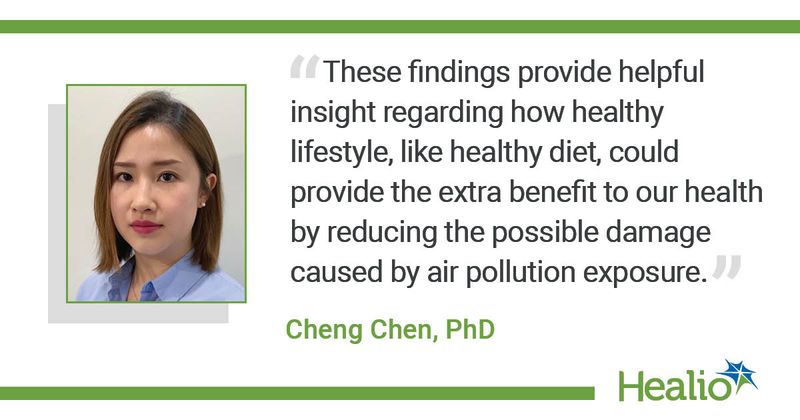Fish consumption may offset effects of air pollution on women’s brains
Eating more fish may help women offset the negative effects of air pollution on brain health, according to a study published in Neurology, the medical journal of the American Academy of Neurology.
Researchers examined data from the Women’s Health Initiative Memory Study-Magnetic Resonance Imaging, an observational study that included women who were aged 65 years to 80 years between 1996 and 1999 and did not have dementia at enrollment. Women in the study completed questionnaires on their diet, physical activity and medical history. The 1,315 women included in the study underwent structural brain MRIs between 2005 and 2006.

Researchers evaluated associations between brain volume and levels of long-chain omega-3 polyunsaturated fatty acids — which play an important part in maintaining brain structure and function while aging — in red blood cells, and exposure to ambient fine particle matter with diameters greater than 2.5 µm (PM2.5), a risk factor for cognitive decline among older adults.
Using the collected information on diet, researchers estimated long-chain omega-3 polyunsaturated fatty acid intake and fish consumption per week, including broiled or baked fish, canned tuna and shellfish. The final analysis did not include fried fish or fried shellfish consumption due to previous research that showed deep-frying these foods damages omega-3 fatty acids.
Researchers used participants’ home addresses to evaluate their 3-year exposure to air pollution. They estimated pollution exposure by modeling daily ambient concentration of PM2.5 across the United States from 1999 to when the MRI scans were performed using data from the U.S. EPA Air Quality System.
After adjusting, researchers found that women with the highest levels of long-chain omega-3 polyunsaturated fatty acids in red blood cells had significantly greater white matter (410.15 cm3) compared with those with the lowest levels (402.68 cm3).
Women living in areas with higher PM2.5 exposure had significantly smaller white volume matter. Among those who had higher long-chain omega-3 polyunsaturated fatty acid levels, the inverse association between PM2.5 and white matter volume were small and not statistically significant. In comparison, the inverse associations between PM2.5 and white matter volume were stronger and significant inverse in women lower levels long-chain omega-3 polyunsaturated fatty acids.
According to the researchers, the findings suggest that higher intake of long-chain omega-3 polyunsaturated fatty acids may help preserve white volume matter during aging and potentially protect against any neurotoxic effects stemming from PM2.5 exposure.

Healio Primary Care spoke with study authors Jiu-Chiuan Chen, MD, ScD, associate professor of preventive medicine at the University of Southern California, Cheng Chen, PhD, of the departments obstetrics and gynecology and epidemiology at Columbia University Irving Medical Center, and Ka Kahe, MD, ScD, MPH, the Virgil G. Damon professor of epidemiology and obstetrics and gynecology at Columbia University’s Mailman School of Public Health, to learn more about the findings.
Q: What prompted you to conduct this study?
JCC: This is a follow-up of our previous study in 2015 showing older women living in locations with higher levels of fine particles in the outdoor air had a smaller volume of white matter. The fine particles are very small, 30 times smaller than the width of the hair. Because these particles are so tiny, they can enter through the respiratory tract directly into the blood circulation system. With the blood flow to the body, they can cause damage to other systems, including the brain. Other studies have found that fish oil may reduce the brain damage caused by exposures to other environmental neurotoxins, including lead and methylmercury. But no study has examined whether fish oil offers similar protection against PM2.5 exposure.
Q: Could the findings impact nutritional guidelines or recommendations?
CC: Based on the data in this single study, we should not jump into recommending major changes to the nutritional guidelines or clinical practice. But since environmental pollution is inevitable in some areas, these findings provide helpful insight regarding how a healthy lifestyle, like healthy diet, could provide the extra benefit to our health by reducing the possible damage caused by air pollution exposure.
Q: What additional work is needed to determine causation between brain function and eating fish?
JCC: Current randomized clinical trials have not provided sufficient evidence supporting the beneficial effects of fish oil supplementation on cognitive decline or neurodegenerative diseases. For this specific topic, future laboratory studies may investigate the underlying mechanisms how omega-3 protects the brain from damage caused by PM2.5.
Q: What should primary care physicians advise patients about fish consumption?
KKH: Our study only found that older women who had a higher blood level of omega-3 had a larger brain volume in white matter; it did not prove that eating fish preserves brain volume. Since separate studies have found some species of fish may contain environmental toxins, it is important to talk to a doctor about what types of fish to eat before adding more fish to your diet.

